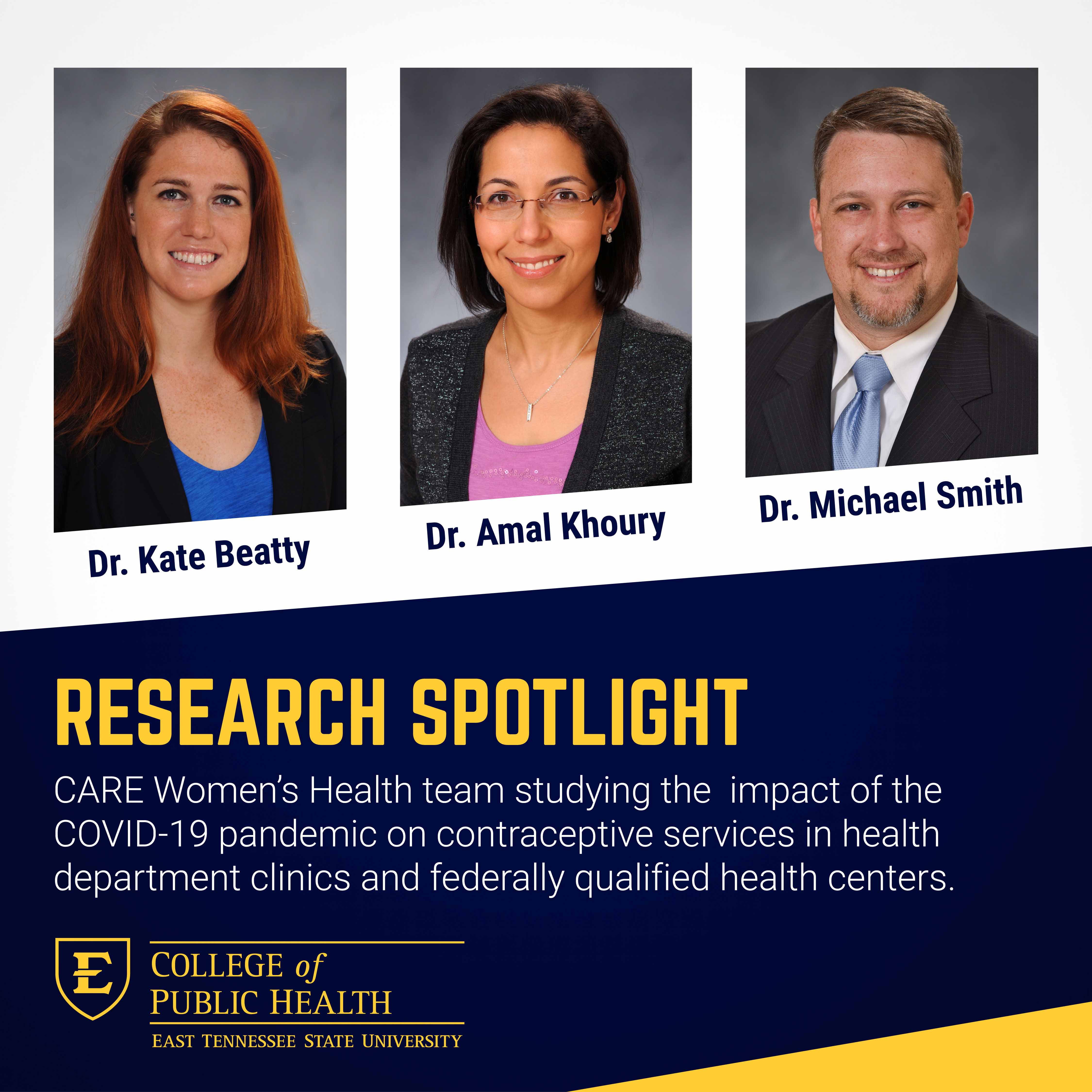Download the Issue Brief: Early Impact of the COVID-19 Pandemic on Contraceptive Services in South Carolina & Alabama
 JOHNSON CITY (Feb. 16, 2021) – The East Tennessee State University Center for Applied
Research and Evaluation in Women’s Health (CARE Women’s Health) is studying the impact
of the COVID-19 pandemic on contraceptive services in health department clinics and
federally qualified health centers (FQHC).
JOHNSON CITY (Feb. 16, 2021) – The East Tennessee State University Center for Applied
Research and Evaluation in Women’s Health (CARE Women’s Health) is studying the impact
of the COVID-19 pandemic on contraceptive services in health department clinics and
federally qualified health centers (FQHC).
Before the arrival of the pandemic, CARE Women’s Health, housed in the ETSU College
of Public Health, had been working with clinical partners in South Carolina and Alabama
on ongoing research related to reproductive health. In early 2020, the center planned
to launch a survey to collect data from family planning clinics across both states.
“We had plans for our survey, but like everyone else, we had to adjust those plans
due to COVID-19,” said Dr. Kate Beatty, core faculty for CARE Women’s Health and principal
investigator of the clinic studies. “Our partners were on the front lines of facing
COVID-19 and were shifting their way of doing business. And because we had to pause
our research here at the university in the early months of COVID-19, we saw it as
an opportunity and updated our data collection to include questions looking specifically
at the impact of COVID-19 on their work.”
In July 2020, the CARE team launched the survey—updated with COVID-specific questions—to
all health department and FQHC family planning clinics in South Carolina and Alabama.
In addition to the surveys, the CARE team also conducted parallel research, interviewing
45 clinic staff and providers to assess the impact of the pandemic on contraceptive
services in their clinics. This week, CARE Women’s health released an Issue Brief discussing their findings.
The surveys and interviews examined issues such as the contraceptive methods the clinics
have continued or stopped providing; changes in their patient volume; availability
of resources and supplies (such as personal protective equipment); temporary clinic
closures, staffing layoffs, furloughs, and absenteeism due to illness; utilization
of telehealth; and COVID-19 screening and testing practices.
“One of the strengths of the way we have been collecting data is that it’s mixed-methods
research,” said Dr. Michael Smith, director of policy and programs for CARE Women’s
Health.
The quantitative data from the surveys illuminated several interesting findings, such
as the fact that approximately one-third of the clinics surveyed added telehealth
to their services during the pandemic. The qualitative data helped tell the story
behind the numbers. For example, their interviews revealed that clinics had different
definitions of telehealth.
“Through the interviews, we learned about underlying factors that we just cannot get
with quantitative data. Putting this information together with a mixed-methods approach
is really powerful for understanding what is going on in these complex situations,”
Smith said.
The team hopes that these findings will shed light on the continued and increasing
importance of supporting the health department clinics and FQHCs in their work to
care for reproductive health. These clinics are often called “safety net” clinics
because they offer essential services to low-income populations and/or patients who
have no insurance or are underinsured.
“The pandemic hit at a time when already clinics were struggling with resources, and
now they’re having to balance these additional challenges,” said Dr. Amal Khoury,
director of CARE Women’s Health. “The past year has been the perfect storm. On one
hand, the clinics are facing additional challenges such as dealing with COVID testing
and vaccines. On the other hand, you have lower-income women in particular bearing
the brunt of this pandemic and facing increasing challenges in accessing the care
they need and being able to pay for the care they need.”
The CARE team has been encouraged to see the innovative ways the clinics have responded
to the challenges. Although telehealth existed before the pandemic, COVID-19 expedited
the infrastructure for it, removing barriers for patients. When telehealth was not
feasible because in-person procedures were required, clinics often adapted and implemented
creative ways to provide those services. For example, some clinics began providing
drive-through service to patients who receive contraceptive injections.
“It’s great to see clinics responding in this way and doing what they can to meet
the needs of their communities,” Khoury said. “Anything that we can as citizens, as
a society or as policymakers do to support them and support the people they serve
will be good and is very much needed.”
“Hopefully this research will highlight the innovations and the challenges that the
health care delivery side is facing, and at the same time underscore the need for
policies to facilitate women’s access to care,” concluded Beatty.
To learn more about CARE Women’s Health, visit www.etsu.edu/cph/care-womens-health.
 Stout Drive Road Closure
Stout Drive Road Closure